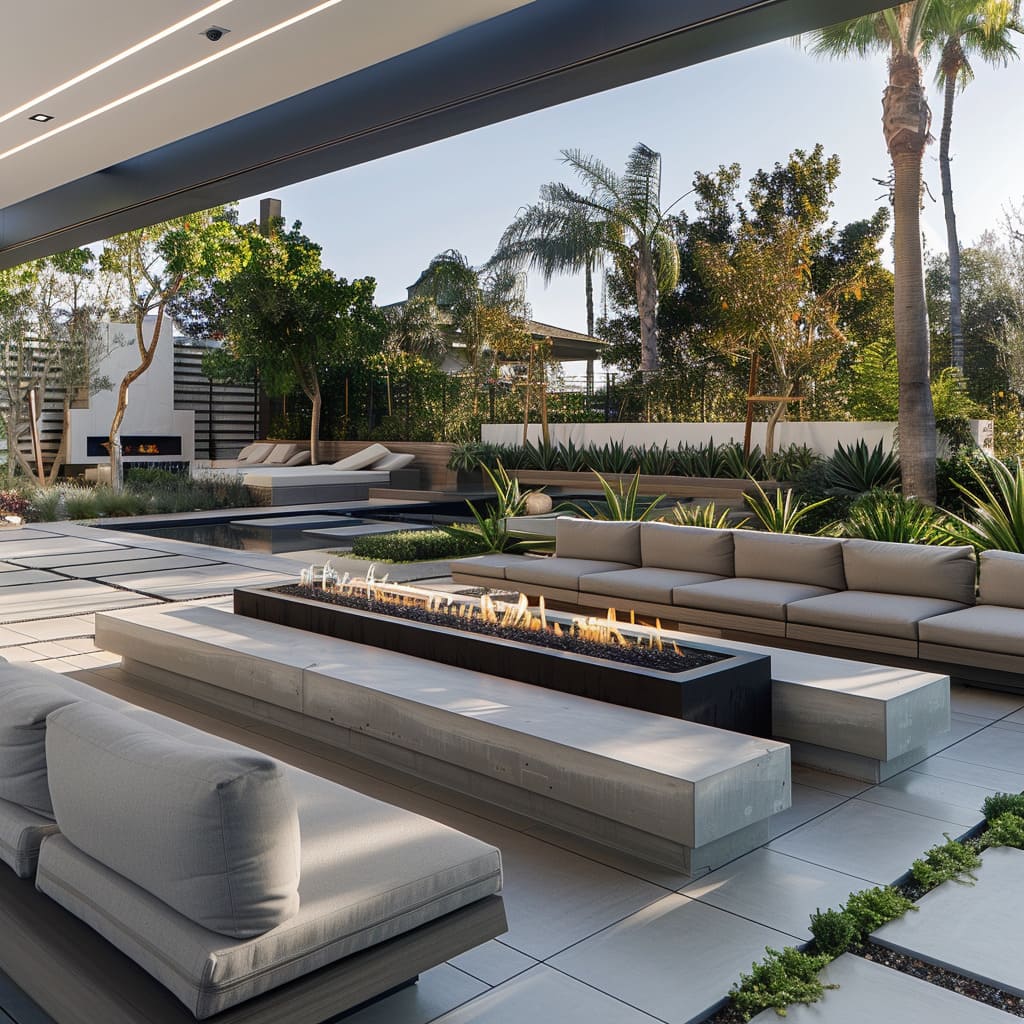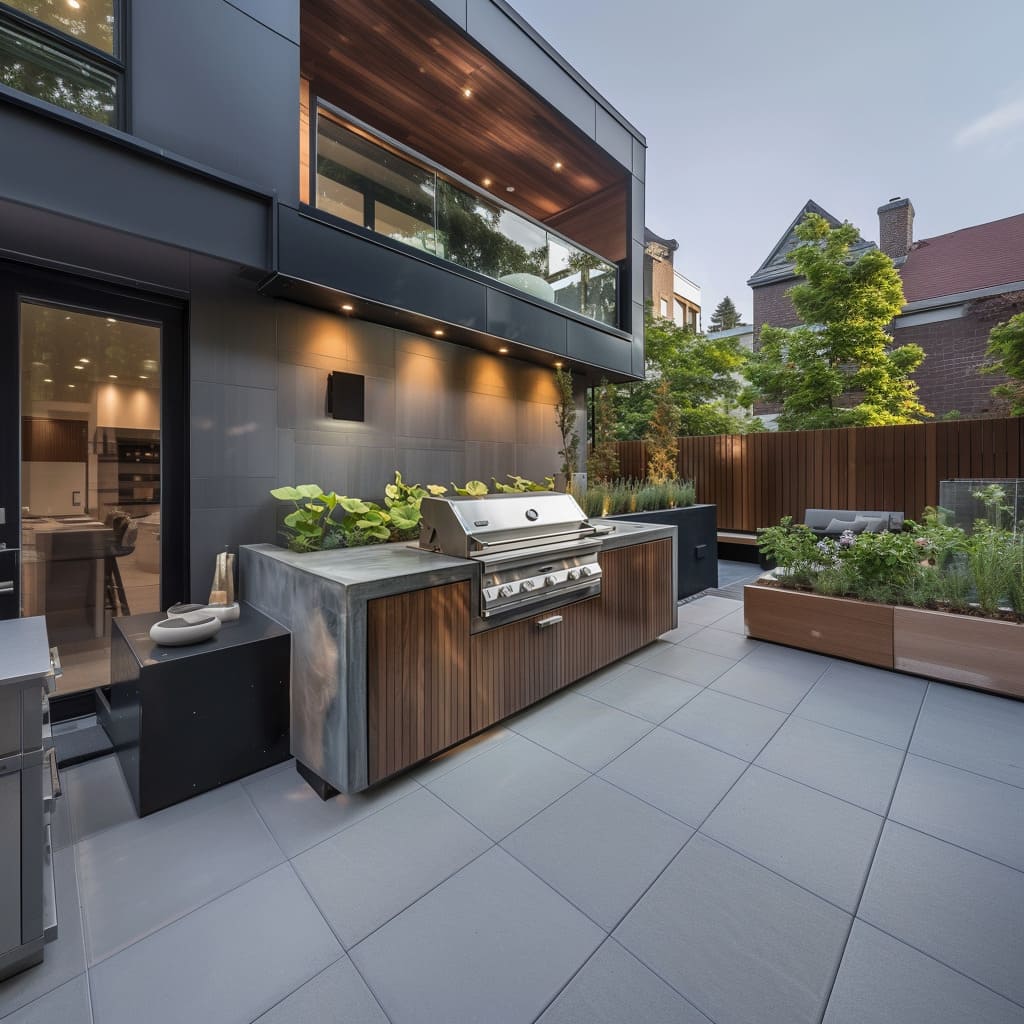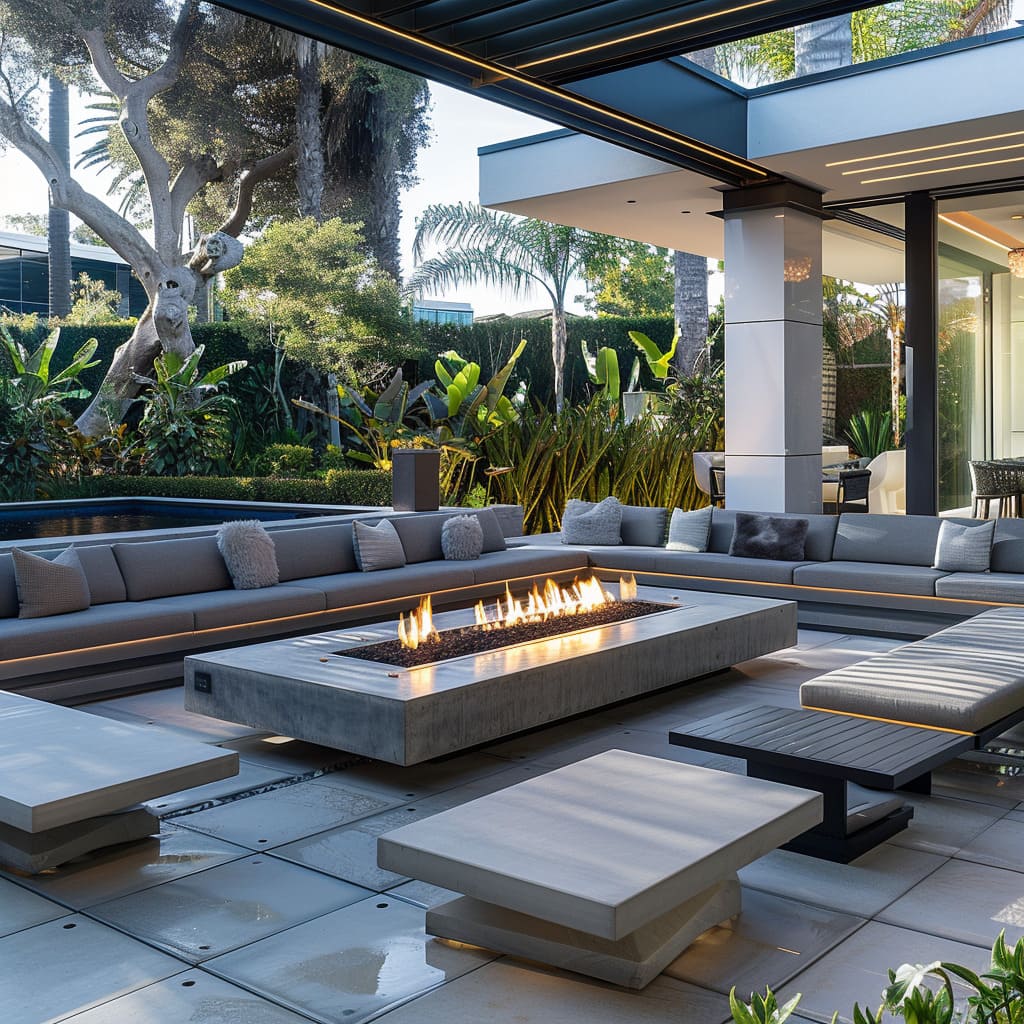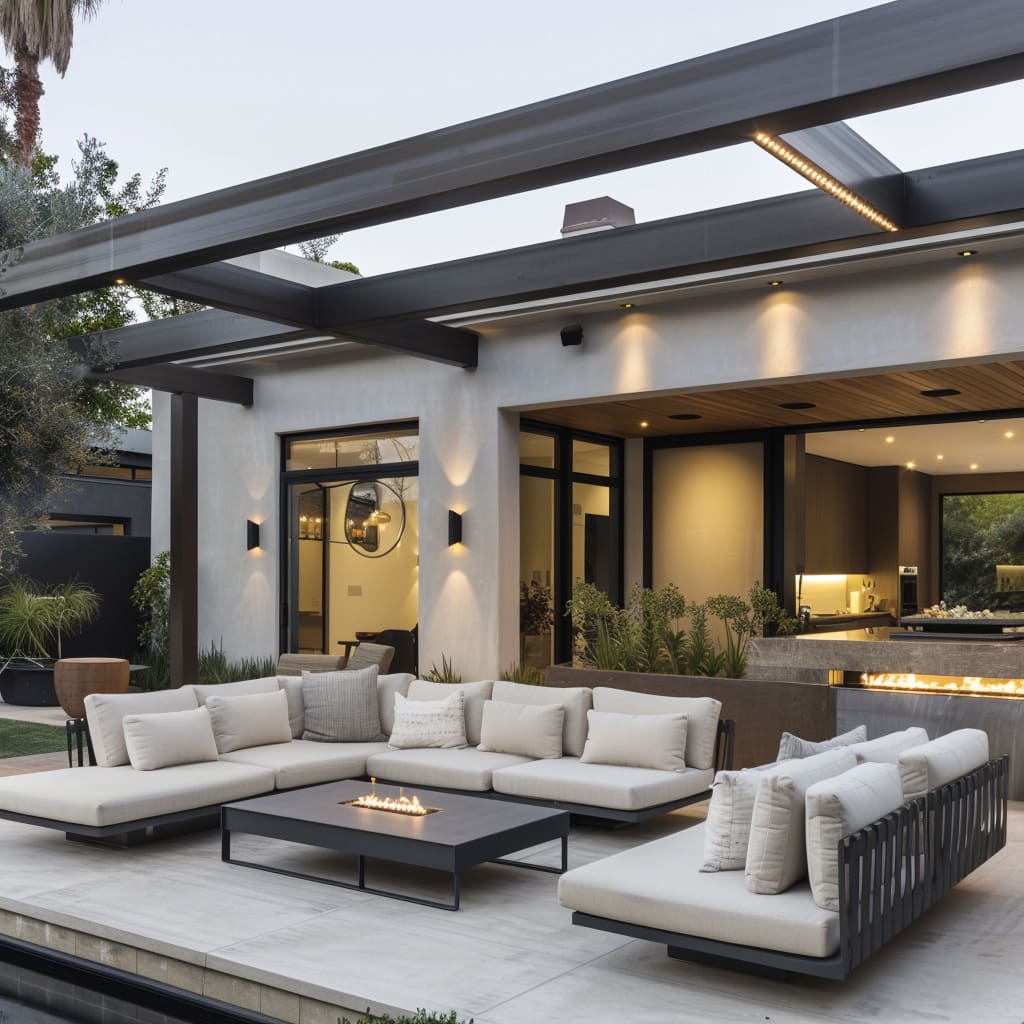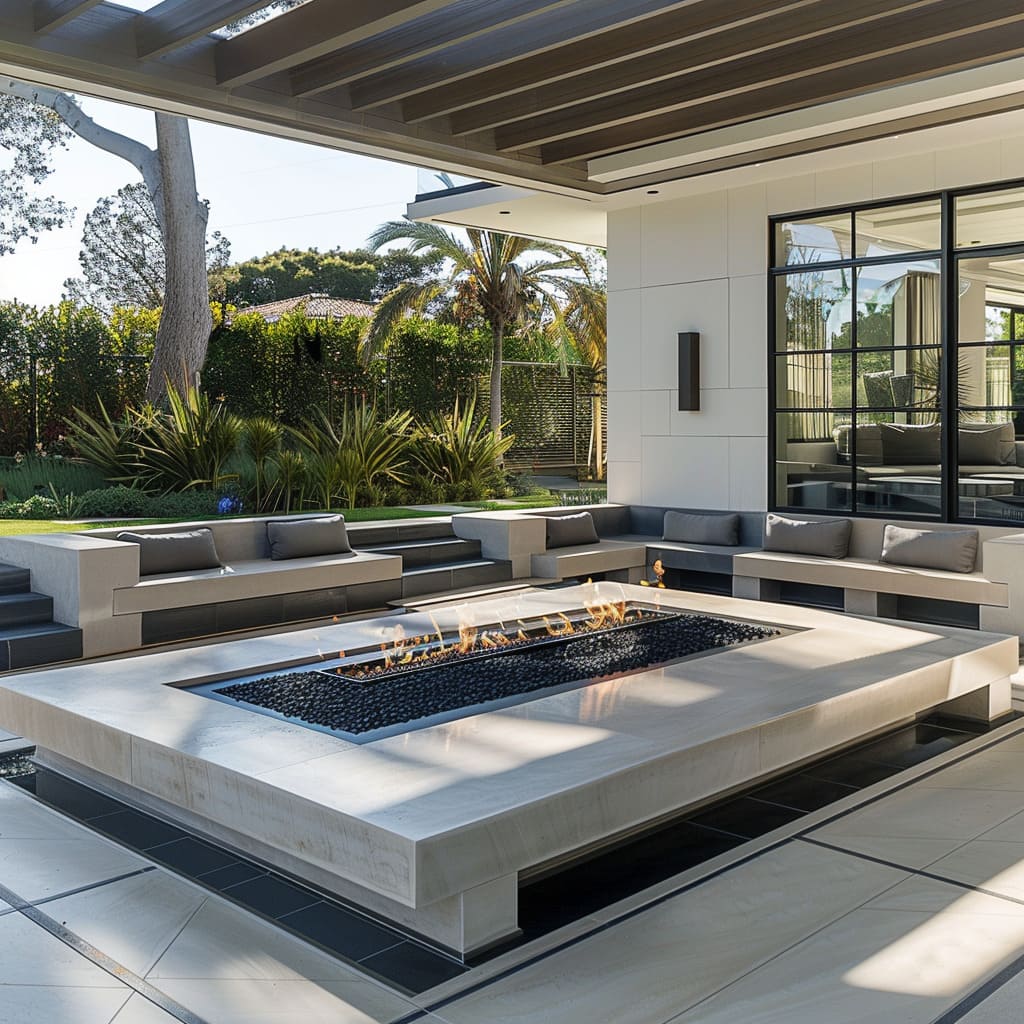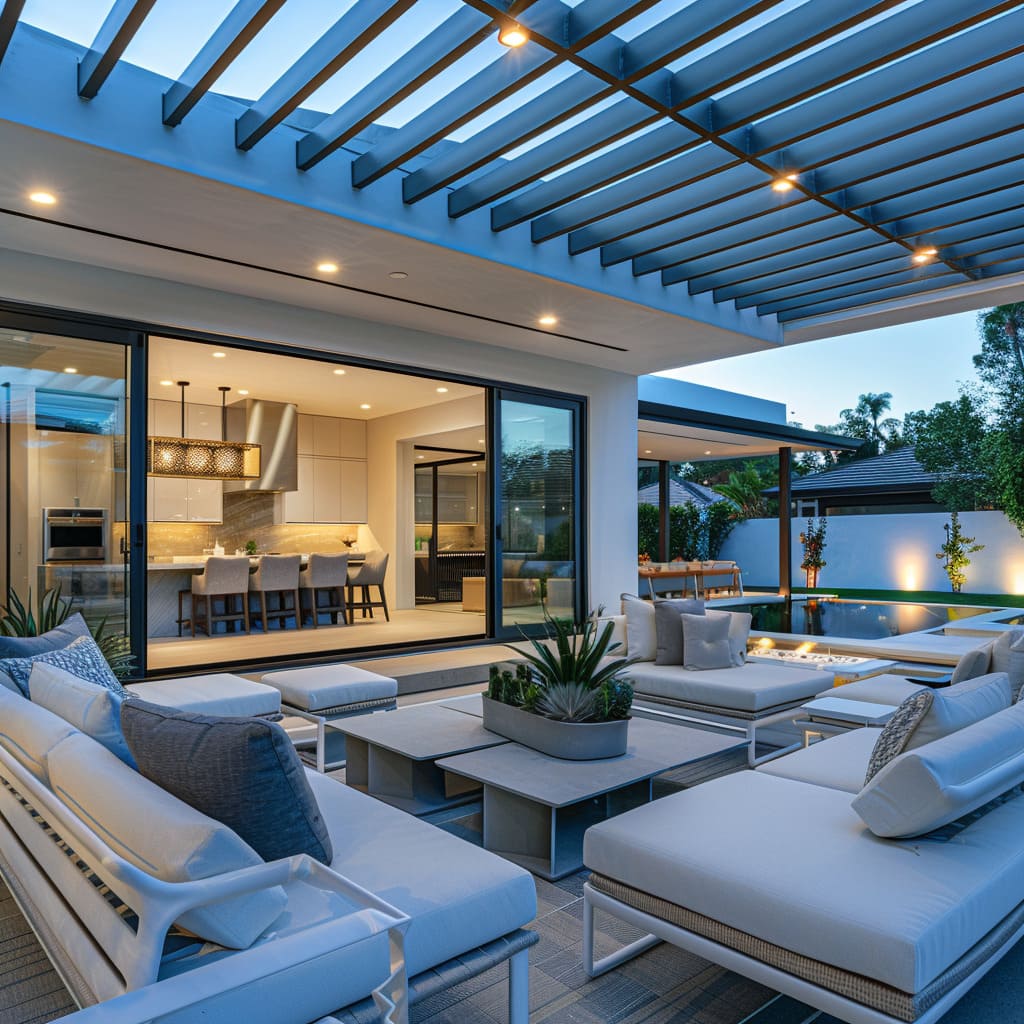Creating an outdoor space that is both sustainable and visually appealing involves careful planning and thoughtful design choices. By focusing on sustainable materials, eco-friendly lighting, and native plants, you can create a space that is not only environmentally responsible but also a pleasure to spend time in.
This article will guide you through the process of designing a beautiful sustainable patio or garden, providing tips and insights on how to make each element work harmoniously.
Sustainable Materials with Aesthetic Appeal
Choosing sustainable materials is the foundation of an eco-friendly outdoor space, but it doesn’t mean you have to sacrifice style. Reclaimed wood is an excellent option for decking and pergolas.
It offers a unique texture and rich tones that add character to any outdoor area. The aged patina and weathered finish of reclaimed wood bring warmth and depth, creating a space that feels grounded and inviting.
Pairing this wood with sleek metal or glass elements can create a striking contrast that modernizes the look while still respecting its rustic origins.
Recycled metals, such as steel or aluminum, can be used in various aspects of your outdoor design, from furniture frames to planters. These materials are not only durable and resilient to weather conditions but also have a polished, contemporary appeal.
They can be shaped into sleek, streamlined forms that contribute to a minimalist aesthetic, which is often favored in modern outdoor spaces. Polished concrete is another sustainable material that can be used for countertops, flooring, or even seating areas.
Its smooth finish and neutral color make it a versatile choice that can complement a wide range of design styles.
How can reclaimed wood be integrated into an outdoor space without compromising its modern aesthetic?
Integrating reclaimed wood into a modern outdoor space can be done beautifully by balancing its rustic charm with sleek, contemporary elements. Start by selecting reclaimed wood that has been carefully finished to highlight its natural grain and character while maintaining a clean look.
Use this wood for large features like decking or pergolas, which can serve as the foundation of the design.
To ensure the space remains modern, pair the reclaimed wood with materials like brushed steel, aluminum, or glass. For example, you might use reclaimed wood for a pergola and complement it with sleek, metal brackets or glass panels.
This combination allows the wood’s natural warmth and texture to shine, while the polished, industrial materials maintain the modern aesthetic.
You can also incorporate reclaimed wood in furniture, choosing pieces with streamlined designs that echo modern lines. Consider using the wood in combination with minimalist metal frames or as accents within larger, more contemporary pieces.
This approach ensures that the space feels cohesive and up-to-date, with the reclaimed wood adding depth and character rather than overwhelming the design.
Additionally, a neutral color palette can enhance the modern feel. Opt for reclaimed wood in lighter tones or apply a subtle stain that complements the space’s overall color scheme.
The key is to create a harmonious blend where the reclaimed wood feels like a natural, integrated element of the modern design, rather than a contrasting feature.
What are the benefits of using recycled metals like steel or aluminum in outdoor furniture and decor?
Using recycled metals like steel or aluminum in outdoor furniture and decor offers several benefits that enhance both sustainability and style. First, recycled metals are environmentally friendly; they reduce the need for new raw materials and minimize waste.
These metals are also highly durable and weather-resistant, making them ideal for outdoor use as they withstand various climates without rusting or deteriorating.
Recycled metals can be crafted into sleek, modern designs, adding a contemporary touch to outdoor spaces. Their ability to be shaped into streamlined forms complements minimalist aesthetics, while their reflective surfaces can create a sense of light and openness.
Moreover, the use of recycled materials contributes to reducing the carbon footprint of the products, aligning with eco-conscious design principles.
In summary, incorporating recycled metals into outdoor furniture not only supports sustainability but also adds durability and a modern flair to the design.
Elegant Eco-Friendly Lighting
Lighting plays a crucial role in the overall ambiance of your outdoor space, and choosing eco-friendly options can enhance the sustainability of your design. Solar-powered lighting is an excellent choice for outdoor areas, as it harnesses the power of the sun, reducing energy consumption and minimizing environmental impact.
Consider positioning solar-powered lanterns along pathways or around seating areas to create a warm and inviting glow. These lanterns come in various designs, from traditional to contemporary, allowing you to choose options that align with your overall aesthetic.
For a more modern look, integrated solar-powered LED strips can be installed under pergolas, along decking edges, or even within the structure of planters. These lights can highlight architectural features, create a sense of depth, and provide practical illumination without being overpowering.
Layering different types of lighting, such as ambient, task, and accent lights, can add dimension to your outdoor space. This approach allows you to adjust the lighting to suit different activities, whether it’s hosting a dinner party, reading a book, or simply relaxing under the stars.
How can integrating solar-powered LED strips under pergolas and along decking edges enhance the visual appeal and functionality of an outdoor space?
Integrating solar-powered LED strips under pergolas and along decking edges can significantly enhance both the visual appeal and functionality of an outdoor space. These LED strips provide subtle, ambient lighting that accentuates architectural features, creating a refined, modern look.
By highlighting the clean lines of a pergola or the edges of a deck, the lighting adds depth and dimension to the space, making it feel more expansive and inviting. Additionally, the soft, even illumination improves safety by clearly defining walkways and seating areas, ensuring that the space is both beautiful and practical, even after dark.
This energy-efficient lighting solution aligns with sustainable design principles, offering a stylish way to reduce energy consumption while enhancing the overall ambiance of the outdoor area.
What are the key factors to consider when selecting the design and placement of solar-powered lanterns to create a warm and inviting atmosphere in an outdoor setting?
When selecting the design and placement of solar-powered lanterns to create a warm and inviting atmosphere in an outdoor setting, consider the following key factors:Design Style: Choose lanterns that complement the overall aesthetic of your outdoor space, whether traditional, modern, or rustic.Lighting Intensity and Color: Opt for lanterns with a warm light color temperature to create a cozy ambiance. Adjustable brightness settings can offer versatility for different occasions.Placement: Position lanterns strategically along pathways, near seating areas, or around focal points to enhance visibility and highlight key features without overwhelming the space.Height and Spacing: Ensure lanterns are placed at varying heights and distances to create visual interest and avoid uniformity.Durability: Select weather-resistant materials to ensure longevity in outdoor conditions.
Lush Landscaping with Native Plants
Incorporating native plants into your outdoor design is an excellent way to create a beautiful and sustainable space. Native plants are adapted to the local climate and soil conditions, which means they require less water and maintenance than non-native species.
This not only conserves water but also supports local wildlife, such as bees and butterflies, which are vital to the ecosystem.
When selecting native plants, consider a mix of textures, colors, and heights to create visual interest. For example, you could combine tall, architectural succulents with lower-growing ground covers and flowering perennials to add depth and layers to your garden.
Palm trees, agave, and yucca are excellent choices for creating a dramatic focal point, while smaller plants like lavender or sage can add fragrance and color.
Geometric planters made from sustainable materials like metal or concrete can further enhance the modern aesthetic of your outdoor space. These planters can be used to create defined planting areas or to frame seating zones, adding structure and formality to the design.
Vertical gardens or green walls are another fantastic option, especially in smaller spaces where ground area is limited. These living walls can be filled with a variety of plants, creating a lush, green backdrop that is both visually striking and space-efficient.
How can combining different textures, colors, and heights of native plants enhance the visual appeal of an outdoor space while maintaining its sustainability?
Combining different textures, colors, and heights of native plants can significantly enhance the visual appeal of an outdoor space while maintaining its sustainability. Varying textures, such as the smooth leaves of succulents with the feathery foliage of ornamental grasses, create a dynamic and engaging landscape.
Incorporating a range of colors, from the deep greens of agave to the vibrant blooms of perennials, adds depth and visual interest. Using plants of different heights helps to layer the garden, creating a sense of structure and fullness that mimics natural ecosystems.
These elements not only make the space visually pleasing but also ensure that it remains low-maintenance and eco-friendly by using plants well-suited to the local environment.
What are the benefits of using geometric planters made from sustainable materials in creating defined planting areas or framing seating zones in a modern outdoor design?
Using geometric planters made from sustainable materials offers several benefits in modern outdoor design. Firstly, these planters provide a defined and organized structure, which helps create clear planting areas and enhances the overall layout of the space.
The geometric shapes add a contemporary, clean-lined aesthetic that complements modern design sensibilities. Additionally, sustainable materials such as recycled metal or concrete ensure that the planters are eco-friendly, aligning with the broader goal of creating a sustainable outdoor environment.
When used to frame seating zones, these planters can also create a sense of enclosure and intimacy, making the seating area feel more integrated into the landscape while maintaining an open and airy feel.
Comfortable and Stylish Seating Arrangements
Comfortable seating is essential for any outdoor space, and there are plenty of stylish options that also prioritize sustainability. Modular seating arrangements offer flexibility, allowing you to rearrange the layout depending on the occasion or your mood.
Look for seating options made from sustainably sourced materials, such as FSC-certified wood or recycled plastic. These materials are not only durable but also environmentally friendly, contributing to the overall sustainability of your space.
Weather-resistant fabrics are crucial for outdoor seating, as they ensure longevity and maintain their appearance despite exposure to the elements. Choose fabrics in neutral tones that can be easily accented with throw pillows or blankets in bolder colors or patterns.
These textiles can add a layer of coziness and invite people to linger longer in the space. Incorporating metallic or wooden details into your seating design can also add a touch of sophistication, elevating the overall look.
How can modular seating arrangements enhance the functionality and adaptability of an outdoor space, particularly in terms of accommodating different activities and group sizes?
Modular seating arrangements offer a dynamic solution for enhancing the functionality and adaptability of outdoor spaces. These seating systems are designed to be easily reconfigured, allowing you to customize the layout to suit different activities and needs.
For example, you can create a cozy, intimate setting for small gatherings or expand the arrangement to accommodate larger groups for parties or events. The ability to rearrange the seating ensures that your outdoor space remains versatile, whether you’re hosting a formal dinner, a casual get-together, or simply enjoying a quiet moment alone.
Moreover, modular seating often comes in sections that can be moved and adjusted individually, giving you the freedom to experiment with different configurations until you find the one that best suits the occasion. This flexibility not only maximizes the use of available space but also allows you to adapt the seating to various layouts, ensuring comfort and accessibility for everyone.
Whether you want to create distinct zones within a larger patio or adjust the seating to capture the best views, modular furniture provides the adaptability needed to make the most of your outdoor environment.
Additionally, modular seating can be complemented with various accessories like side tables, ottomans, and cushions, further enhancing its versatility. The ability to easily incorporate these elements into the seating arrangement means you can quickly transform the space to meet different functional and aesthetic needs, making it an essential component of any well-designed outdoor area.
What are the key benefits of choosing weather-resistant fabrics for outdoor seating, and how can these fabrics be effectively incorporated into the overall design to maintain both comfort and style?
Choosing weather-resistant fabrics for outdoor seating offers several key benefits, ensuring that your furniture remains durable, comfortable, and stylish despite exposure to the elements. These fabrics are specifically designed to withstand harsh weather conditions, including UV rays, rain, and humidity, which prevents fading, mold, and mildew.
This longevity means your seating will maintain its appearance and functionality over time, reducing the need for frequent replacements.
Incorporating weather-resistant fabrics into your design allows for a wide range of colors, textures, and patterns, giving you the flexibility to create a cohesive look that complements your outdoor space. Opt for neutral tones for a timeless, versatile base, and enhance comfort and visual interest with colorful or patterned throw pillows and blankets that can be easily switched out for a refreshed look.
These fabrics ensure that outdoor seating remains inviting and comfortable, offering a seamless blend of practicality and style in your outdoor design.
Incorporating Water Features
Water features can be a stunning addition to an outdoor space, providing both visual interest and a soothing soundscape. When selecting a water feature, consider designs that align with the overall aesthetic of your space.
Sculptural water features with clean, minimalist lines can serve as a focal point, drawing the eye and creating a sense of tranquility.
Solar-powered water features are an excellent choice for sustainable outdoor spaces, as they rely on renewable energy sources. These features can be placed in strategic locations where they can be appreciated from multiple angles, such as at the end of a pathway, beside a seating area, or within a garden bed.
The reflective surface of the water can also enhance the natural light in your space, creating a dynamic interplay between light and shadow throughout the day.
How can the placement of a water feature in strategic locations, such as at the end of a pathway or beside a seating area, enhance the overall design and functionality of an outdoor space?
The placement of a water feature in strategic locations like the end of a pathway or beside a seating area can significantly enhance the design and functionality of an outdoor space. At the end of a pathway, a water feature serves as a visual anchor, drawing the eye and providing a focal point that guides movement through the space.
This placement can create a sense of journey or discovery, making the garden feel more expansive and thoughtfully designed.
Beside a seating area, a water feature adds a soothing soundscape, enhancing the ambiance and making the space feel more relaxing and intimate. The gentle sound of water can mask background noise, creating a peaceful retreat.
Additionally, placing the feature near seating allows for closer appreciation of its aesthetic and sensory qualities, enriching the overall outdoor experience. Strategically positioned water features also interact with natural light, casting reflections and creating a dynamic interplay between light and shadow, which adds depth and visual interest to the space throughout the day.
What are the benefits of choosing solar-powered water features for sustainable outdoor spaces, and how do they contribute to the ambiance and environmental impact of the area?
Choosing solar-powered water features for sustainable outdoor spaces offers several benefits that enhance both the ambiance and environmental impact of the area. One of the primary advantages is that these features operate using renewable energy, significantly reducing the carbon footprint and lowering energy costs.
They are easy to install and require minimal maintenance, as they do not rely on electrical wiring or external power sources.
From an aesthetic perspective, solar-powered water features contribute to a tranquil atmosphere, with the gentle movement and sound of water adding a soothing element to the space. Their placement can enhance natural light reflections, creating a dynamic interplay of light and shadow that changes throughout the day.
By opting for solar-powered options, you ensure that your outdoor space remains eco-friendly while maintaining a visually appealing and relaxing environment.
Balancing Aesthetics and Functionality
Creating a sustainable outdoor space that is both functional and visually appealing requires careful consideration of all design elements. The key is to ensure that every component, from the furniture to the plants to the lighting, works together to create a cohesive and inviting environment.
Start by establishing a color palette that reflects the natural surroundings, using earthy tones, deep greys, and soft metallics. This palette can be carried through in the materials you choose, the textiles you incorporate, and the accessories you add.
When arranging furniture, consider the flow of the space and how people will move through it. Ensure that there is enough space for comfortable circulation, and that seating areas are positioned to take advantage of the best views or natural light.
Incorporating natural elements like wood, stone, and plants can soften the lines of modern furniture and create a more welcoming atmosphere. Finally, consider how the space will be used at different times of the day and in various weather conditions.
Adding shade structures, like pergolas or umbrellas, can provide relief from the sun, while outdoor heaters or fire pits can extend the usability of the space into cooler evenings. By carefully balancing aesthetics with functionality, you can create an outdoor space that is not only beautiful but also practical and enjoyable to use.
Case Study: A Beautifully Designed Sustainable Outdoor Space
Let’s explore a real-life example of a beautifully designed sustainable outdoor space that incorporates all the elements discussed above. Imagine a patio with reclaimed wood decking, bordered by sleek metal planters filled with native succulents and flowering plants.
A modern pergola made from dark-stained wood and steel provides shade over a comfortable seating area, where modular sofas are arranged around a sculptural, solar-powered water feature.
The lighting is carefully designed, with solar-powered lanterns illuminating the pathway to the garden, while integrated LED strips highlight the architectural features of the space. The color palette is neutral and calming, with earthy tones in the wood, deep greys in the concrete countertops, and soft metallics in the furniture accents.
This space is not only visually stunning but also highly functional, offering areas for dining, relaxation, and socializing. Every element, from the plants to the lighting to the seating, has been thoughtfully chosen to create a harmonious and sustainable outdoor environment that invites people to relax and enjoy the beauty of nature.
Conclusion
Designing a sustainable outdoor space that is both beautiful and functional is a rewarding challenge. By carefully selecting materials, incorporating eco-friendly elements, and balancing aesthetics with practicality, you can create a space that is not only environmentally responsible but also a joy to spend time in.
Whether you’re building a new patio or revamping an existing garden, these design tips will help you create a space that reflects your style and values while respecting the natural world.




